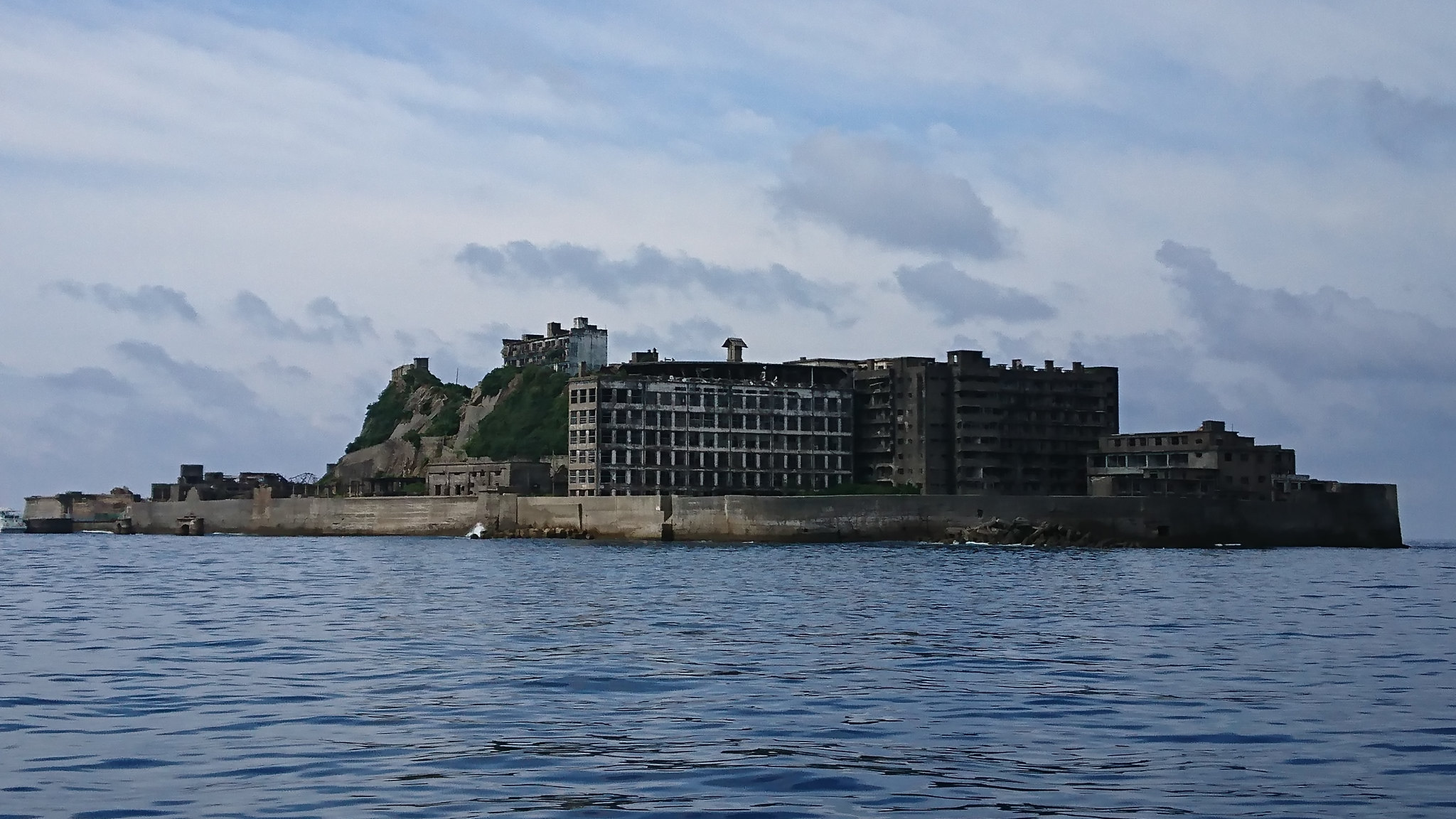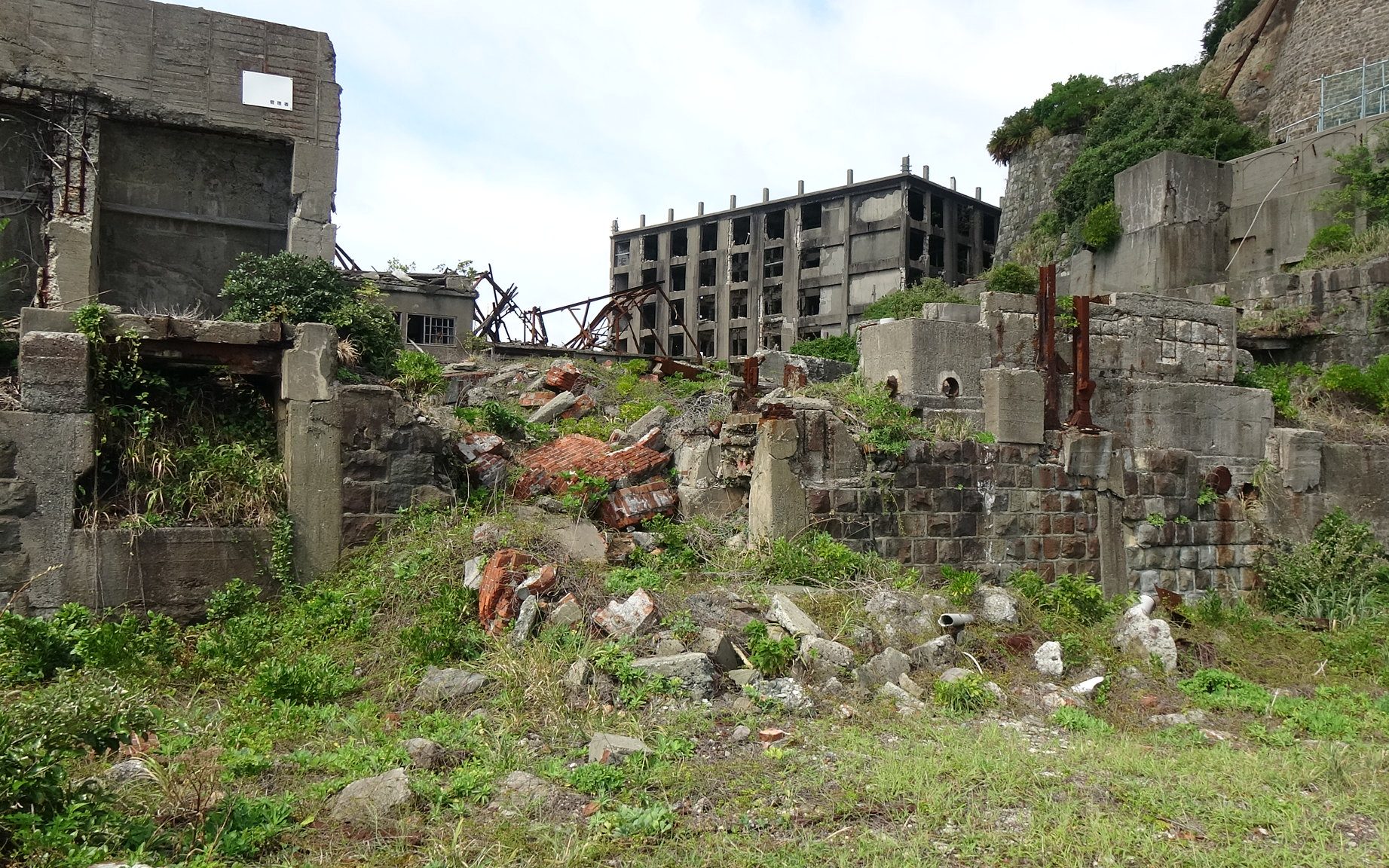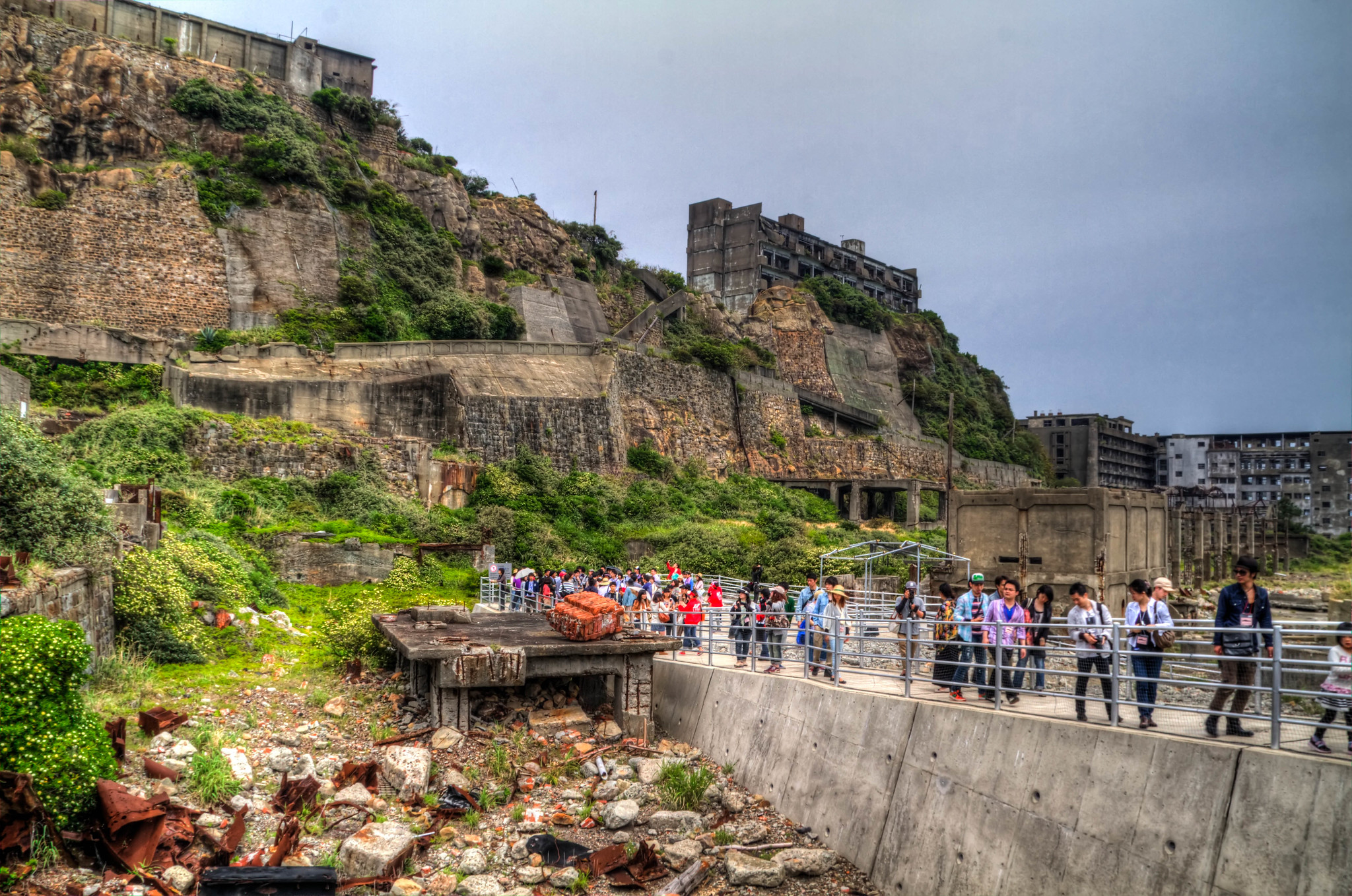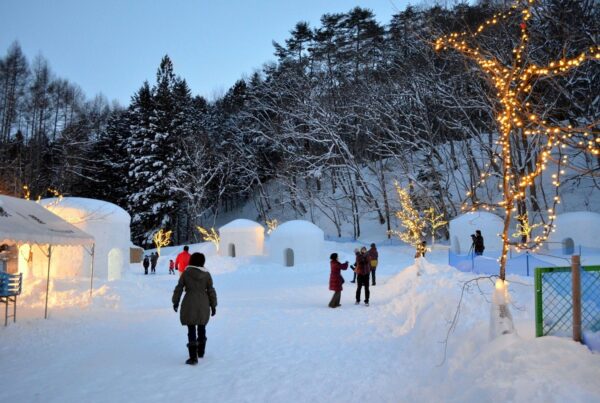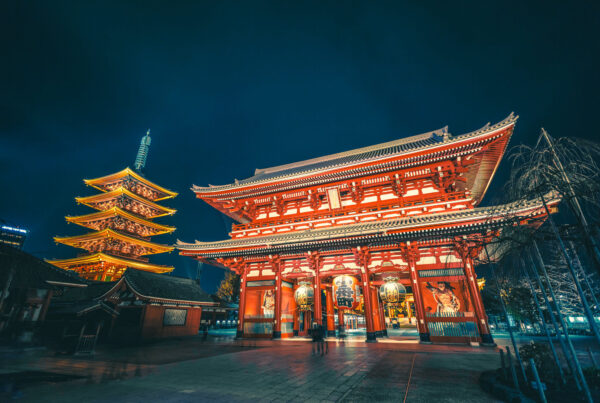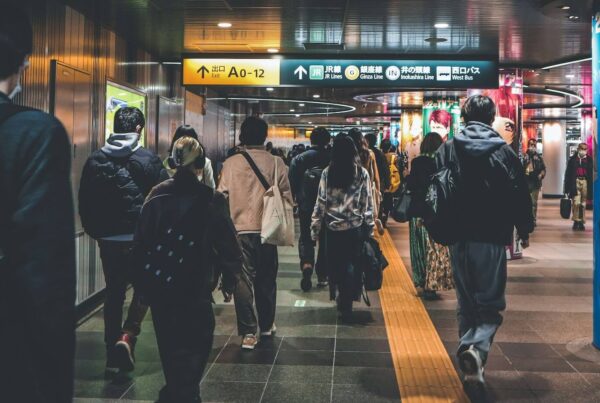Eerie. Haunted. Disturbing. These are all words used to describe Gunkanjima. It makes you wonder the exact reason why this tiny uninhabited island is filled with derelict tower blocks and a labyrinth of concrete staircases. Even more mysteriously, why did it once hold the record for the highest population density in the world? An extraordinary amount of people lived in this very small space, 5259 residents across 0.063 km² to be precise. Yet today, the only life present is from visiting birds and the occasional cockroach. It is completely abandoned.
Lying off the southwest coast of the Nagasaki Prefecture, its official title is Hashima Island. Gunkanjima (Japanese for battleship) was the name given to the island by locals as its shape holds striking similarities to the Japanese battleship Tosa. It has been said that the entire community departed Hashima Island with curious haste, leaving odd shoes and clothing items behind. Rumour has it that even lesson inscribed blackboards were found. Hashima Island was closed with strictly prohibited access for 35 long years. Then, in 2009, it reopened, also becoming a UNESCO World Heritage Site. This eerie little island undoubtedly hides a few interesting stories beneath it’s cold and grey exterior. A trip here will certainly raise as many questions as it answers.
Table of Contents
History
The real story of Gunkanjima starts with the discovery of coal under the island in 1810. Fast forward to 1890, and the Japanese Industrial Revolution was well underway. Daily life had changed as employment moved from the fields and into the factories. Japan was modernising and industries, such as the railways, were rapidly developing. Consequently, Hashima Island became an attractive investment opportunity due to its abundance of coal.
Voir cette publication sur Instagram
The Mitsubishi Corporation bought the island and transformed it. They built sea walls to protect the islanders from typhoons and tripled the island’s size through land reclamation. It became a prosperous coal mining facility with an enormous workforce to match. Mitsubishi wanted to maximise the space on the island to accommodate its army of workers. The high rise nature of the architecture reflects the necessity to build up instead of out.
Life on the Island
Island life involved plenty of hustle and bustle as the coal industry boomed. Construction was rapid as it needed to cater for a population density around 18 times greater than Tokyo at the time. The layout of Gunkanjima was staggering. It was a meticulously designed labyrinth of corridors and staircases. It included apartment blocks, a cinema, a swimming pool, shops, and even a pachinko parlour. The island was equipped with a hospital and an elementary and junior high school. There was also a post office which was an important link to the outside world.
Fundamentally, Mitsubishi had to make the island an attractive place to live. There needed to be an incentive for workers to want to relocate with their families. A generous hardship bonus was paid to compensate the miners for the trouble of living on a remote island. Consequently, the residents could afford luxury items such as televisions before the Japanese middle classes even could!
For all intents and purposes, the island was a spirited community. The residents enjoyed living there. Coal miners could refresh their dirty faces after a tough shift down the mines in one of four communal bathing facilities. Japan’s first rooftop garden was created, a trend that is still popular today in urban areas short on green spaces. The annual sports day was always enthusiastically attended as were the seasonal festivals. Gunkanjima became an emblem for contemporary development. Some argue that it laid the groundwork for Japan’s eventual status as a modern economic superpower.
- Credit : flickr/ckleung
- Credit : flickr/ckleung
In 1916, Gunkanjima saw Japan’s first steel-framed reinforced concrete building constructed. These buildings could withstand intense amounts of stress. They would go on to hold high architectural significance on the island. Following the Great Kanto Earthquake of 1923, reinforced concrete became the mainstream method of construction for large buildings across Japan. They proved to be effective as a defensive barrier against the ever-looming threat of natural disasters.
However, it wasn’t all bean bag races and dancing. Mining work was notoriously difficult, involving long hours in hot working conditions. Before the final closure of the mines, the miners were so deep underground, that they were close to magma. Dangerous problems arose with gases seeping into the mines. At its peak, the mine was in operation 24 hours a day and run by 800 employees daily.
Controversy
Unfortunately, there are issues even more worrying than this. The island has been embroiled in accusations of severe human rights abuses. Before and during the Second World War, Korean and Chinese prisoners of war were sent to the mines for the purpose of slave labour. They were forced to do the most treacherous aspects of mining. Tragically, many prisoners died from underground accidents, exhaustion or malnutrition. Survivors have retold stories of ‘the coal dust falling from their faces into their food’ after punishing days of back breaking work. Official records indicate that there were cremations of 1,162 Japanese, 122 Koreans and 15 Chinese on the island between 1925 and 1945. However, the actual number of deaths is likely to be far higher. According to other records, ‘around 722 Chinese workers and 1,442 Korean labourers died on the island by the end of WWII’. These conflicting sources suggest that it is unlikely anyone will ever know the true figures.
The Korean government strongly opposed Unesco’s wishes to make Gunkanjima a world heritage site as the application failed to make any reference whatsoever to the horrors of its wartime conduct. They claimed that the Japanese government was attempting to erase its unpleasant history, instead, preferring to promote Gunkanjima as a shining symbol of modernisation in Japan. It is worth noting here that Mitsubishi insists that all compensation and reparation demands were settled by postwar treaties. An island shrouded in death will always hold an unsettling air of grief and distress, no matter how you dress it up.
Read also:
Dark Tourism in Japan – 10 Spots for an Exhilarating Travel Experience
The Decline
In 1960, petroleum took over as the primary source of fuel in Japan and the coal industry was almost immediately rendered as unprofitable. The island and the mines shut down, with all its inhabitants leaving for work back on the mainland. Without the mines, there was simply no reason for anyone to stay on Gunkanjima.
Mitsubishi closed the mine in January 1974, and the island was officially emptied of its inhabitants on April 20 of the same year. What remained, was only memories and the empty buildings of a time now locked in history. The once flourishing hub of industrial activity became lifeless. It became the forgotten island.
Fun Facts
Gunkanjima recently received global attention as a setting inspiration for the 2012 Bond film Skyfall. Block 65 was used as the lair of the evil Bond villain Raoul Silva. The derelict and sinister grey buildings offered the perfect setting for the huge blockbuster. CGI scenes of the island’s exterior can also be seen in the film when Bond is aboard the Pruva Regina Yacht. As he draws closer to the island’s edges, there is a definite sense of foreboding and unease, as he sees the mysterious and menacing buildings ahead.
Watch the scene here:
How to visit Gunkanjima island?
Regardless of your reasons for wanting to visit Gunkanjima, it is undoubtedly a fascinating insight into Japan’s accelerated industrial development. The only way you can visit the island is by guided tour. Gunkanjima Concierge offers three hour cruises that run daily from Nagasaki. If you do intend on taking a trip, wear sunscreen. Another top tip is to use the bathroom before leaving as there are no facilities on board and definitely no facilities on the island. Also, be aware that large parts of the island are considered unsafe as typhoons have battered the structures leaving most of them unstable and potentially dangerous.
- Credit : flickr/kentamabuchi
- Credit : flickr/rwoan

Credit: japan-guide.com
On days where a sea crossing is not possible, visitors can enjoy the Gunkanjima Digital Museum. The museum uses the latest digital technology to educate you on the Industrial Revolutionary Heritage of the Meiji Period, obviously focusing on Gunkanjima. The museum even shows you the restricted areas of the island which you can not see on the landing tour.
Website: https://www.gunkanjima-concierge.com/en/about/
Price: 4,500yen for a weekend day, 4000 for a weekday.
Read also:
Nagasaki Japan – A Complete Travel Guide To Read Before Your Trip
Conclusion – Gunkanjima
A trip to Gunkanjima offers you the chance to really feel the spirit of the island, imagining the difference experiences had there and an opportunity to actually follow in the footsteps of the miners, their families, the prisoners of war and a Bond villain, each offering a very different perspective of this unique and mysterious island.
Be sure to follow us on Facebook, Instagram, Twitter, and Pinterest for more fun stuff! See you again next time!

Lizzy Currie
Originally from England, Lizzy has finally made her dreams of moving to Japan a reality. For as long as she can remember, Lizzy has been dazzled by the bright lights of Tokyo and enchanted by the historic streets of Kyoto. She loves dining out, hates people who talk too much in meetings and enjoys a good ten hour sleeping marathon at the weekend.


